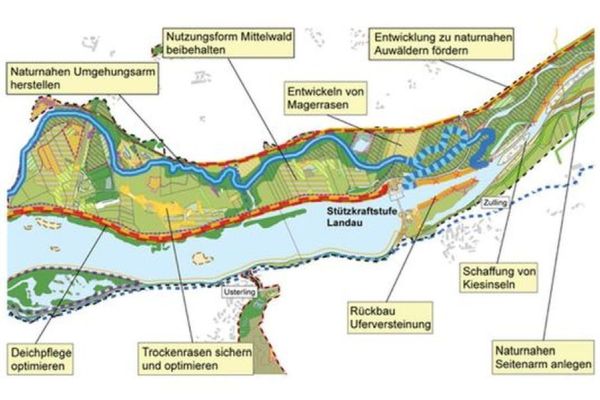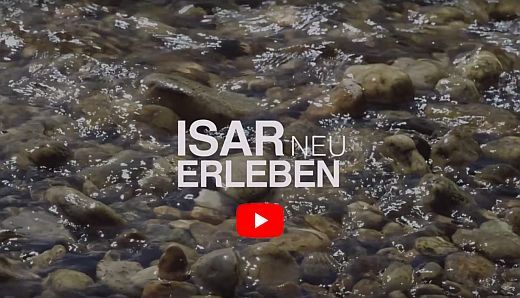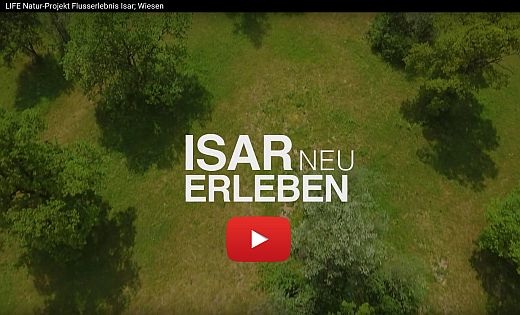"River Experience Isar" - the name says it all
The Isar River - hardly any river is as closely related to the Bavarian history and tradition. Despite its Tyrolean origin it is and will remain the river of the Bavarian people.
The Isar has always been considered "torrential", wild and dangerous. Not surprising - given that its flood waters have always had the capacity to administer sudden hardship and destruction to the nearby population. Once, its braided course and spacious gravel banks were proof of the untamed force of the Alpine stream.
Since the mid-19th century the Lower Isar has been fortified, straightened, embanked and finally, converted into a chain of reservoirs, primarily for the purpose of taming its flood waters, but also in an effort to reclaim land and generate power. Today, seven barrages with locks interrupt the flow of the river between Landshut and Deggendorf. Therefore, the river is neither passable for gravel and scree nor fish nor other organisms. Besides, almost the whole lakeshore is obstructed with stone blocks and is hence not accessible for the population.
Nowadays, the river is only allowed to flow freely in the area immediately below the barrages. The gravel banks and islands, the branches, the bank scars and floodplain waters that used to be typical for this river have disappeared deteriorated, severely decimating the flora and fauna. The river has turned from a vital line of our homeland to a mere barrier and alien element.
The time has now come to restore the river to its old glory. Together with numerous partners and supporters from the region, the Wasserwirtschaftsamt Landshut (Water Management Authority of Landshut) and the Regierung von Niederbayern in their capacity as Höhere Naturschutzbehörde (the higher Nature Conservation Authority of the Government of Lower Bavaria) have teamed up to restore the Isar River to a more natural state in the context of the EU-sponsored LIFE project. To allow everyone to experience the Isar River with all of their senses and, at the same time, give nature back a piece of river landscape that is alive and vibrant - this is our objective!
Keyword "LIFE Nature":The LIFE-Nature programme, which was first implemented in 1992, is the EU's funding instrument for nature conservation projects. LIFE-Nature specifically contributes to the implementation of the Habitats and Birds directives and, in particular, the Natura 2000 European network of protected areas. So its main objective is to support the implementation of nature conservation actions in protected areas under the Habitats Directive and EU bird sanctuaries.
Flyer
- General Flyer River Experience Isar - PDF
- Layman's Report on the LIFE Nature Programme - 7 years Isar river experience - PDF
Occasion
The Landshut paradigm
The conservation and restoration of ecologically intact rivers involves enormous and diverse challenges. The Government of Lower Bavaria, higher Nature Conservation Authority, and the Water Management Authority of Landshut combined their efforts in the "Landshut paradigm" and have developed comprehensive ecological concepts for the rivers Vils, Danube and Isar since 1995.
Ecological development concept for the river Isar
In 2010 the largest planning project in terms of surface area to date was initiated - the nearly 30 km long river section between the barrages of Gummering and Ettling. The entire area of the Natura 2000 site "SCI DE7341301 Unteres Isartal zwischen Niederviehbach und Landau" was part of the planning area. The overall planning was completed in the middle of 2012. Concerning the hydro-ecological revaluation of the regulated and channeled Isar, the focus lies on the heads of the reservoirs, which still possess enough fluid energy in the tailwaters of the barrages to initiate near-natural morphodynamic processes - for example after the removal of bank reinforcements. Besides, large-scale measures were worked out to create and optimize near-natural alluvial forests and extensive meadows typical for floodplains.
 Ecological development concept for the river Isar, view of action plan
Ecological development concept for the river Isar, view of action plan
The results of the ecological development concept indicated that many of the proposed measures operate in a multifunctional manner concerning the implementation of important EU directives of nature conservation (Habitats Directive) and water management (Water Framework Directive). The partners of the "Landshut paradigm" have thereupon increased their efforts to bundle the financial resources of nature conservation and water management and specifically use them also for an effective implementation of restoration measures.
Grant application for the LIFE nature project "River Experience Isar"
In August 2013, following several constructive considerations and discussions, the Bavarian State Ministry for Environment and Consumer Protection with its departments for water management and nature conservation decided to fund a joint restoration project and therefore to apply for additional resources from EU's funding program "LIFE". Furthermore the cities of Dingolfing and Landau a.d.Isar, the district of Dingolfing-Landau and the Bavarian Nature Conservation Funds have agreed to participate in the financing of the project. With the professional support of an external consultant office, the Government of Lower Bavaria, higher Nature Conservation Authority, and the Water Management Authority of Landshut developed the project application covering almost 300 pages from January to September 2014. After a one year-long revision period by the EU-commission the application was approved in October 2015. The LIFE Nature Project "River Experience Isar" is the 23rd Bavarian LIFE project with a total budget of about 6,3 Mio €, which is the highest so far.
Project area
The original appearance of the alpine and pre alpine river Isar has been greatly changed. From the middle of the 19th century immense modifications have been made due to flood protection measures, but also for the production of energy by hydraulic engineering (Channeling, obstruction of the banks), intensification of land use and housing development. The ecological function of the river as well as the alluvial floodplains and the natural dynamics of the alluvial floodplains have hence been greatly reduced. Multiple damming of the river bed has profound effects on migration of all organisms and also prevents the transportation of river material. Former structures, habitats or species that were characteristic for this area have now disappeared or have been greatly constricted. Nowadays, the lower Isar is only allowed to flow freely in the area immediately below the barrages. Despite the serious disturbances, there is still a wide range of valuable species and habitats occurring in the entire project area. This concerns mainly the river Isar with the still persisting alluvial water bodies and its accompanying soft- and hardwood alluvial forests as well as species-rich extensive meadows, especially on low-nutrient sites such as shallow and porous gravel soils, dykes and dams. Large parts of the area are therefore designated as Natura 2000 sites. However, decisive habitat types such as the soft- and hardwood alluvial forests are mainly in an average to poor state of preservation. Regarding animal species, it is mainly the populations of the typical freshwater fish species, such as huchen, asp and streber, which have been greatly reduced.
Project objectives
The main aim of the LIFE project is to improve the typical water body structures of the Isar, especially through restoration measures along the river banks. Thus, the living conditions of freshwater fish species such as huchen, asp, barbel and nase will be substantially improved. At the same time, the Isar should be made accessible again and therefore the recreational value of the river landscape will be increased.
Specific project aims are to:
- Improvement of the river dynamics by optimising near-natural shore and water body structures
- Conservation and optimisation of alluvial water bodies (backwater, oxbow lakes, tidal pools, temporary small bodies of water)
- Development of near-natural soft- and hardwood alluvial forests
- Conservation, optimisation and increasing of the dry habitats that are typical for floodplains
Measures
Subject area of water (about 3.36 Mio.€)
- Recreation of richly structured embankment
- Development of gravel banks and shallow water zones
- Restoration of undeveloped embankments
- Creation of semi-natural shore and channel structures
- Ecological enhancement of a rubble drain
- Semi-natural design of an existing floodplain channel
- New creation of an Isar branch
- Recreation and optimisation of floodplain waters
Subject area of wood (about 560.000 €)
- Conversion of thick floodplain shrubs to tiered floodplain forests
- Development and optimisation of hardwood and softwood floodplain forests that are typical for the location
- Recreation of hardwood and softwood floodplain forests
- Rehabilitation of pollard willows
Subject area of meadows (about 370.000 €)
- Development of limestone grassland
- Development of lowland hay meadows
- Floristic enhancement of the meadows
Organization
- Organizational Chart - PDF
Schedule
The project runs from October 2015 to December 2022.
Together with the project application a detailed timetable was established. As a result, the different key subjects have been staggered over time. The main hydro-engineering restoration measures will take place as follows:
- Territory of Dingolfing 2017 - 2018
- Territory of Landau 2018 - 2020
- Territory of Loiching 2019 - 2021
The forest planning will be implemented gradually, starting in summer 2017 with the alluvial forests in the territory of Goben. First measures of improving lowland hay meadows will be carried out in the territory of Ettling. This section is scheduled to start in the spring of 2018.
Imagefilm Life Nature Project River Experience Isar

Imagefilm Life Nature Project River Experience Isar; Meadows

